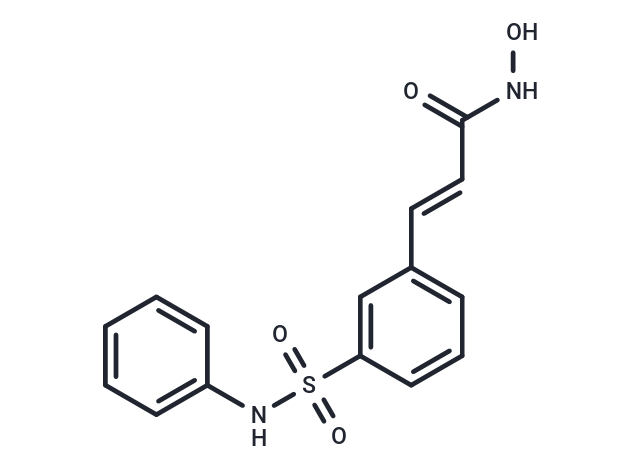购物车
- 全部删除
 您的购物车当前为空
您的购物车当前为空

Rac-Belinostat (PX-105684) 是一种具有抗肿瘤活性的新型异羟肟酸型组蛋白脱乙酰酶 (HDAC) 抑制剂。 Belinostat 靶向 HDAC 酶,从而抑制肿瘤细胞增殖、诱导细胞凋亡、促进细胞分化和抑制血管生成。这种药物可以使耐药肿瘤细胞对其他抗肿瘤药物敏感,可能是通过一种涉及胸苷酸合酶下调的机制。

Rac-Belinostat (PX-105684) 是一种具有抗肿瘤活性的新型异羟肟酸型组蛋白脱乙酰酶 (HDAC) 抑制剂。 Belinostat 靶向 HDAC 酶,从而抑制肿瘤细胞增殖、诱导细胞凋亡、促进细胞分化和抑制血管生成。这种药物可以使耐药肿瘤细胞对其他抗肿瘤药物敏感,可能是通过一种涉及胸苷酸合酶下调的机制。
| 规格 | 价格 | 库存 | 数量 |
|---|---|---|---|
| 1 mg | ¥ 119 | 现货 | |
| 5 mg | ¥ 236 | 现货 | |
| 10 mg | ¥ 388 | 现货 | |
| 25 mg | ¥ 630 | 现货 | |
| 50 mg | ¥ 893 | 现货 | |
| 100 mg | ¥ 1,310 | 现货 | |
| 200 mg | ¥ 2,090 | 现货 | |
| 1 mL x 10 mM (in DMSO) | ¥ 308 | 现货 |
| 产品描述 | Rac-Belinostat (PX-105684) is a novel hydroxamic acid-type histone deacetylase (HDAC) inhibitor with antineoplastic activity. Belinostat targets HDAC enzymes, thereby inhibiting tumor cell proliferation, inducing apoptosis, promoting cellular differentiation, and inhibiting angiogenesis. This agent may sensitize drug-resistant tumor cells to other antineoplastic agents, possibly through a mechanism involving the down-regulation of thymidylate synthase. |
| 靶点活性 | HDAC:27 nM |
| 体外活性 | 在鼠膀胱细胞中,Belinostat诱导p21WAF1, HDAC 核心和细胞通讯基因.在A2780和A2780/cp70 移植瘤中,Belinostat(10 mg/kg)可明显延迟肿瘤生长,但不影响动物体重.Belinostat(100 mg/kg)单独处理A2780移植瘤,可使肿瘤抑制率达47% ,该作用存在剂量依赖性.Belinostat(100 mg/kg)和Carboplatin(40 mg/kg)联用可在18.6-22.5 天延迟肿瘤生长时.此外,作用于携带抗Bortezomib UMSCC-11A移植瘤的鼠时,该化合物显示肠胃毒性.硼替佐米与Belinostat联用对肿瘤显著抑制效果. |
| 体内活性 | Belinostat 对A2780/cp70 和2780AD细胞的活性很低, 这两个细胞由抗阿霉素及顺铂的A2780细胞衍生。在卵巢癌细胞系中,Belinostat可增强微管乙酰化。 Belinostat对肿瘤细胞生长(包括A2780, HCT116, HT29, WIL, CALU-3, MCF7, PC3,及HS852)有抑制作用(IC50:0.2-0.66 μM)。通过组蛋白H3/H4乙酰化和PARP分裂,Belinostat可诱导细胞凋亡。 Belinostat抑制膀胱癌细胞尤其是5637细胞的生长,细胞在G0-G1期积累, 在S期下降,在 G2-M期上升。 Belinostat对细胞生长活性的抑制作用与多重耐药表现型无关,但是多西他赛的活性明显受影响。Belinostat 可增强卡铂或多西他赛对A2780和OVCAR-3细胞活性的抑制。在TGF-β信号依赖机制中,Belinostat使蛋白激酶A激活并使survivin mRNA降低。 |
| 激酶实验 | Histone Deacetylase Activity: Subconfluent cultures are harvested and washed twice in ice cold PBS and pelleted by centrifugation at 200 × g for 5 min. The cell pellet is resuspended in two volumes of lysis buffer [60 mM Tris buffer (pH 7.4) containing 30% glycerol and 450 mM NaCl] and lysed by three freeze (dry ice) thaw (30 °C water bath) cycles. Cell debris is removed by centrifugation at 1.2 × 104 g for 5 min, and the supernatant is stored at ?80 °C. Histone H4 peptide (sequence SGRGKGGKGLGKGGAKRHRK corresponding to the 20 NH2-terminal residues) is acetylated by a recombinant protein containing the hypoxanthine-aminopterin-thymidine domain of p300, using [3H]acetyl CoA as a source of acetate. H4 peptide (100 μg) is mixed with hypoxanthine-aminopterin-thymidine buffer (50 mM Tris HCl pH 8.0, 5% glycerol, 50 mM KCl, and 0.1 mM EDTA), 1 mM DTT, 1 mM 4-(2-aminoethyl) benzenesulfonylfluoride, 1 × complete protease inhibitors, 50 μL of purified p300, and 1.85 m [3H]acetyl CoA (4.50Ci/mmol) in a final volume of 300 μL and incubated at 30 °C for 45 min. The p300 protein is removed by incubation with 20 μL of 50% Ni-agaroase beads for 1 hour at 4 °C and centrifugation. The supernatant is applied to a 2 mL Sephadex G15 column, and the flow through is collected. One milliliter of distilled Water is gently applied, and three drop fractions are collected; this is repeated until 4–5 mL of distilled Water has been added, and ~40 fractions are collected. Three microliters of each fraction are diluted in 2 mL of scintillation fluid and counted in a scintillation counter to identify the fractions containing the labeled peptide. These fractions are pooled, and 1 μL of the combined sample is measured to assess the radioactivity in every peptide batch (3-7×103 cpm/μL). For activity assays, the reaction is carried out in a total volume of 150 μL of buffer [60 mM Tris (pH 7.4) containing 30% glycerol] containing 2 μL of cell extract and, where used, 2 μL of belinostat.The reaction is started by the addition of 2 μL of [3H] labeled substrate (acetylated histone H4 peptide corresponding to the 20 NH2-terminal residues). Samples are incubated at 37 °C for 45 min, and the reaction stopped by the addition of HCl and acetic acid (0.72 and 0.12 M final concentrations, respectively). Released [3H]acetate is extracted into 750 μL of ethyl acetate, and samples are centrifuged at 1.2× 104 g for 5 min. The upper phase (600 μL) is transferred to 3 mL of scintillation fluid and counted. |
| 细胞实验 | Tumor cell lines are seeded in 5 mL of medium at a density of 8 × 104 cells/25 cm2 flask and incubated for 48 hours. Cells are exposed to Belinostat (0.016 to 10 μM) for 24 hours. The medium is removed, and 1 mL of trypsin/EDTA is added to each flask. Once the cells have detached, 1 mL of medium is added, the cells are resuspended, and those from the control untreated flask are counted. Cells are diluted and plated into 6-cm Petri dishes (three per flask) at a density of 0.5-2× 103 cells/dish depending on the cell line. Cells from the drug-treated flasks are diluted and plated as for the control flasks. Dishes are incubated for 10–15 days at 37 °C. Cells are washed with PBS, fixed in methanol, and stained with crystal violet, and colonies that contained ≥50 cells counted. Sensitivity is expressed as the IC50 defined as the concentration of belinostat required to reduce the number of colonies to 50% of that of the control untreated cells.(Only for Reference) |
| 别名 | PXD101, PX-105684, NSC726630 |
| 分子量 | 318.35 |
| 分子式 | C15H14N2O4S |
| CAS No. | 414864-00-9 |
| Smiles | ONC(=O)\C=C\c1cccc(c1)S(=O)(=O)Nc1ccccc1 |
| 密度 | 1.427g/cm3 |
| 存储 | Powder: -20°C for 3 years | In solvent: -80°C for 1 year | Shipping with blue ice. | |||||||||||||||||||||||||||||||||||
| 溶解度信息 | Ethanol: < 1 mg/mL (insoluble or slightly soluble) H2O: < 1 mg/mL (insoluble or slightly soluble) DMSO: 65 mg/mL (204.18 mM) | |||||||||||||||||||||||||||||||||||
溶液配制表 | ||||||||||||||||||||||||||||||||||||
DMSO
| ||||||||||||||||||||||||||||||||||||
评论内容